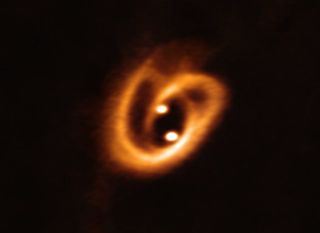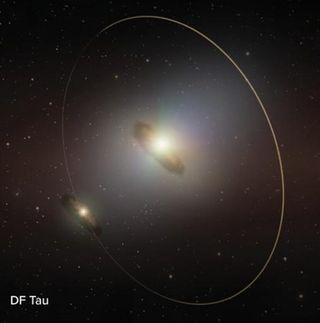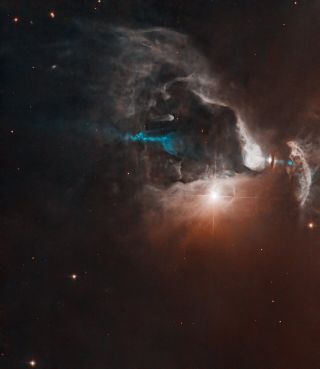Astronomers have gained new knowledge about the formation of planets around twin stars orbiting each other.
Although we are most familiar with planets orbiting a single central star – like the layout of our solar system – more than 50% of the stars in the cosmos exist in a binary system, meaning they have one star companion. These binary systems may also be surrounded by planets that orbit one of the stars in a “circumstellar orbit” or that loop both stars in a much larger “circumbinary orbit.”
Using the Atacama Large Millimeter/submillimeter Array (ALMA) – made up of a combination of 66 radio telescopes located in northern Chile – and the 10-meter Keck II telescope in Hawaii, astronomers collected data on two systems of twin stars. What they discovered could transform our understanding of the conditions that can promote or inhibit such planet formation in binary systems.
Related: Like in the 90s, binary stars are back in fashion
Are two stars better than one for the birth of a planet?
Binary star formation is not much different from single star formation. These bodies are created when dense clouds of cold interstellar gas form overly dense areas that gather more mass, eventually collapsing under their own gravity to give birth to a stellar child called a “protostar.”
This protostar continues to gather material from its prenatal cocoon of gas and dust until it has enough mass to trigger the nuclear fusion of hydrogen into helium in its core, the process that defines a main sequence star. It is important to note that some of these interstellar clouds are large enough to allow two or even three main sequence stars to form within them.
Then, whatever is left of this cloud of gas and dust after these stars formed surrounds them as what astronomers call a “protoplanetary disk.” As the name suggests, planets form from these disks. Like the planets themselves, disks can be circumstellar, surrounding a single star, or circumbinary, surrounding the entire system.

Scientists currently do not know the factors that allow these disks to remain long enough to give rise to planets, nor do they know what ultimately causes them to dissipate. It turns out that the circumstellar disks of binary pre-main-sequence proto-star systems could be the ideal laboratories to study these questions.
Properties of these early disks, such as their sizes, substructures, and even inclinations (relative to protostar characteristics such as rotation speed and magnetic field strength) can reveal details about the complex interactions that shape these environments of birth of planets.
Additionally, the ubiquity of multi-star systems in the universe means that studying planet formation around twin stars is vitally important to understanding this process at a deeper level.

One of the binary systems the team worked on with ALMA and Keck II was DF Tau, composed of two protostars with masses about 0.6 times that of the sun and located about 150 light years away. of Earth, in the star formation region of Taurus.
The two stars of DF Tau are separated by a distance equivalent to about 14 times the distance between Earth and the sun; it takes them about 44 Earth years to complete their very elongated orbits.
Fascinatingly, ALMA detected that the interstellar cloud responsible for the birth of these stars had split into two circumstellar disks. One of them is magnetically locked to the central star, DF Tau A, and actively feeds it matter to facilitate its growth. The other appears to have broken away from the other star, DF Tau B. The central region of the disk appears eroded as the young star spins rapidly.
This suggested to the team that there might be a link between the rotation of young stars as well as the magnetic locking of disks onto them, and thus the early dissipation of those from the disks. In addition to this, it appears that misalignments between DF Tau’s orbit, its circumstellar disks, and the tilt of its stars may impact the general evolution of the disk.

The second binary system the team focused on was the very young FO Tau system, 2.8 million years old (for context, remember that the solar system is 4.6 million years old) . billion years).
This system is also located about 450 light years from us. Its stars, FO Tau A and B, are in a more circular orbit than those of DF Tau. They are also more widely separated, with FO Tau B orbiting FO Tau A at a distance equivalent to about 22 times the distance between Earth and the sun.
Thanks to ALMA, astronomers discovered that FO Tau’s disks are aligned with the orbit of this binary. Both stars exhibit rotation rates on the slower side and both circumstellar disks remain magnetically locked to their protostars. This indicates that systems like FO Tau, with slower stars and more circular orbits, might be better suited to forming planetary bodies around its two stellar components than fast systems with elongated orbits.
ALMA observations of other single and binary stellar disks have revealed complex substructures within the disks, including features such as spiral patterns, gaps, and ring formations.
Although, at present, these structures are not visible for DF Tau and FO Tau, determining the larger-scale properties of these two nearby binary systems has significantly advanced our understanding of planet-forming environments.
The team’s results were revealed at the 244th meeting of the American Astronomical Society (AAS).